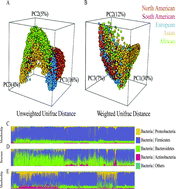Host genetics is associated with the gut microbial community membership rather than the structure†
Abstract
The issue of what factors shape the gut microbiota has been studied for years. However, questions on the contribution of host genetics to the colonizing process of the gut microbiota and to the extent that host genetics affect the gut microbiota have not yet been clearly answered. Most recently published reports have concluded that host genetics make a smaller contribution than other factors, such as diet, in determining the gut microbiota. Here we have exploited the increasing amount of fecal 16S rRNA gene sequencing data that are becoming available to conduct an analysis to assess the influence of host genetics on the diversity of the gut microbiota. By re-analyzing data obtained from over 5000 stool samples, representing individuals living on five continents and ranging in age from 3 days to 87 years, we found that the strength of the various factors affecting the membership or structure of the gut microbiota are quite different, which leads us to a hypothesis that the presence or absence of taxa is largely controlled by host genetics, whereas non-genetic factors regulate the abundance of each taxon. This hypothesis is supported by the finding that the genome similarity positively correlates with the similarity of community membership. Finally, we showed that only severe perturbations are able to alter the gut microbial community membership. In summary, our work provides new insights into understanding the complexities of the gut microbial community and how it responds to changes imposed on it.


 Please wait while we load your content...
Please wait while we load your content...